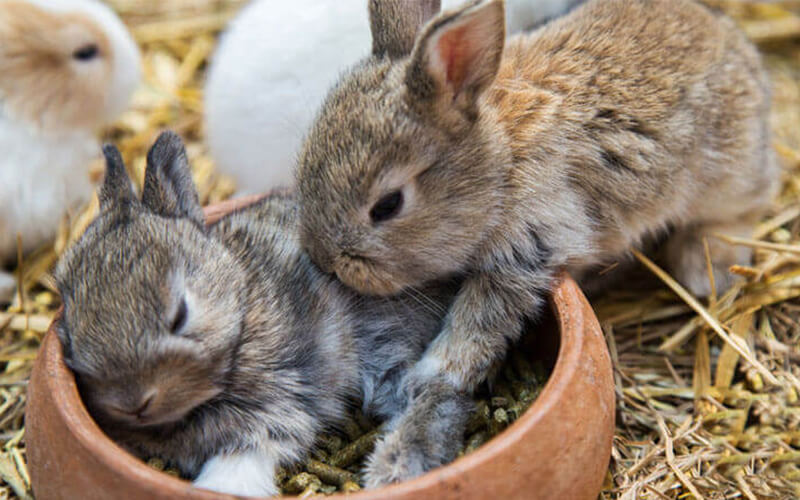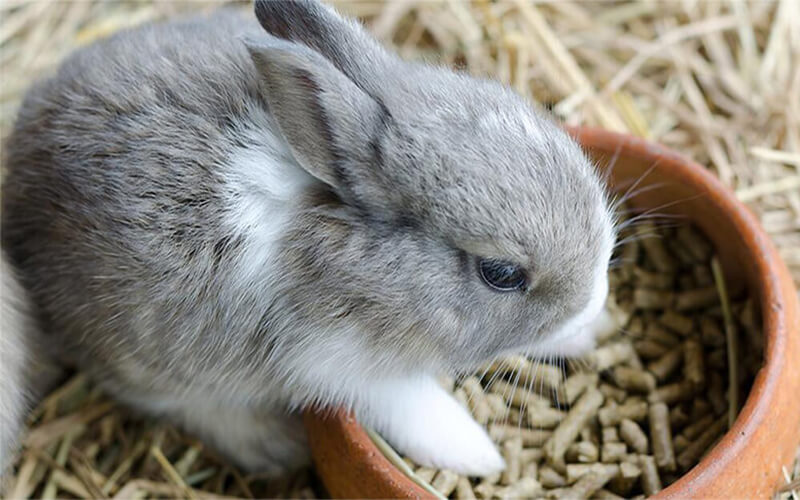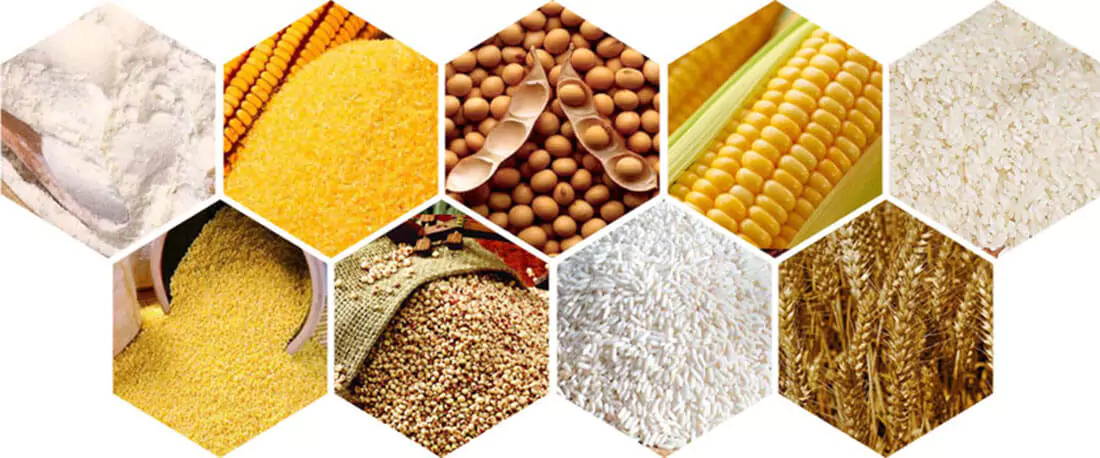Introduction
Have you ever stood in a store, looked at the long list of ingredients on a bag of rabbit food, and felt a little overwhelmed? You’re not alone. It can be hard to know what all those words mean. But understanding these ingredients is the key to choosing the best food for your rabbit’s health. It helps you look past the confusing marketing claims and feel confident about what you’re feeding your rabbit.
This guide will break down the main raw materials used in making a balanced and healthy rabbit feed. After reading this, you’ll understand what your rabbits are eating and why each component is so important.
what kind of feed for rabbits?
Green Feed
Green fodder is rich in nutrients, rich in chlorophyll, vitamins, minerals and other substances. It has good palatability, rabbits love to eat it, and has high digestibility. Common green feeds are wild grasses, vegetables, pastures, forage crops, vegetable leaves, young leaves, non-starchy roots, tubers, melons, and fruits.
roughage
Rough rabbit feed, under 45% moisture and over 18% crude fiber, includes hay and straw. It’s bulky, nutrient-poor, varies in protein, and is hard to digest, with high fiber but low digestible energy. Commonly used ones include green hay, straw, and pods.
energy feed
Energy feed is rich in nitrogen-free extract, offering high energy value for rabbits. This type of feed has good palatability and high digestibility, and plays an extremely important role in rabbit breeding. Commonly used ones include corn, sorghum, rice bran, wheat bran, etc.
protein feed
Protein feed includes plant protein feed, animal protein feed, single cell protein feed and non-protein nitrogen feed. Commonly used ones include legumes, distiller’s grains, fish meal, meat meal, bone meal, blood meal, feed yeast, etc.
Additive feed
Additives are naturally the addition of various nutrients to the feed. Their functions enhance feed nutrition, boost utilization, promote rabbit growth, and prevent diseases. Reduce the nutritional loss of feed during storage and improve product quality.


What is the Most Important Ingredient in Rabbit Feed?
This is the number one rule of rabbit nutrition. The most important part of any rabbit’s diet is fiber.
Fiber Sources (The Absolute Foundation of a Rabbit’s Diet)
Why it’s so important:
The most critical ingredient for any rabbit is fiber. A rabbit’s unique digestive system is designed to constantly process high-fiber foods. Fiber keeps their gut moving correctly. It helps wear down their continuously growing teeth. And it prevents serious health problems like GI stasis.
Key Hays to Use:
Most of this fiber should come from hay. Good examples include: Timothy Hay (an excellent all-around choice for adult rabbits), Alfalfa Hay (this is higher in protein and calcium, making it good for young, growing rabbits or for pregnant or nursing does), Orchard Grass, and Oat Hay.
Other Fiber Sources:
In a pelleted feed, you might also see other fiber sources like Soybean Hulls or Beet Pulp (the kind without added molasses).
What Other Ingredients Are Used in a Rabbit Feed Formulation?
Besides fiber, a balanced rabbit pellet will contain these other key parts.
Protein Sources (For Body Maintenance & Growth)
What they do: Protein provides the building blocks to build and repair a rabbit’s body tissues.
Examples: Common protein sources are Soybean Meal (very effective), Canola Meal, and Sunflower Meal. It’s important to know that the protein needs for healthy adult rabbits (around 12-14%) are lower than for many other animals.
Energy & Carbohydrate Sources (Used in Moderation)
What they do: These ingredients provide the energy for daily activities like hopping and playing.
Examples: Good sources include Wheat Middlings, Barley, and Oats. It is very important that high-starch grains like corn are used in very small amounts or avoided completely.
Vitamins & Minerals (The Essential Extras)
What they do: Think of these as the “spark plugs” of the body. They are crucial for overall health, strong bones, and a healthy immune system. Rabbits only need them in tiny amounts, but they are absolutely essential.
How they’re added: “These are almost always added as a complete ‘rabbit vitamin and mineral premix.’ This is the only safe and reliable way to ensure your rabbits get the correct balance of vital nutrients like Vitamin A, D, E, and important minerals like Zinc and Copper.”
Fats (For Energy and a Healthy Coat)
What they do: Fats are a concentrated source of energy. They also help with maintaining a healthy, shiny coat for your rabbit.
Examples: Small amounts of Vegetable Oil or Flaxseed (which is a good source of healthy Omega-3 fatty acids) are often used.
What Ingredients Should Be Limited or Avoided in Rabbit Feed?
A healthy rabbit feed is just as much about what isn’t in it as what is.
High-Starch Grains and Ingredients:
“Ingredients like corn, high amounts of wheat, or peas should be strictly limited in a rabbit’s diet. Too much starch can easily upset a rabbit’s sensitive digestive system. This can lead to serious and sometimes dangerous health issues.”
Sugary Additives and Treats:
“Avoid feed formulas that include sugary ingredients like molasses or dried fruit as a main component. These are high in sugar. They should only be considered a very occasional treat, not a part of their staple daily diet.”
Nuts and Seeds:
“These are far too high in fat for a regular rabbit diet. They can cause obesity and other related health problems.”
Best rabbit feed formulation ingredients for different stage
Growing Rabbit Feed Formulation Ingredients
| Ingredient | Percentage |
|---|---|
| Rice | 25% |
| Corn | 25% |
| Bean cake | 15% |
| Rapeseed cake | 7% |
| Malt root | 10% |
| Bran | 16% |
| Inorganic salts & vitamin mix | 2% |
Pregnant rabbit feed Formulation Ingredients
| Ingredient | Percentage |
|---|---|
| Barley | 15.0% |
| Corn | 10.0% |
| Wheat bran | 15.0% |
| Soybean meal | 5.0% |
| Rapeseed cake | 8.0% |
| Malt root | 10.0% |
| Silkworm excrement | 5.0% |
| Alfalfa powder | 10.0% |
| Straw powder | 20.5% |
| Inorganic salt additive | 1.5% |
Lactating rabbit feed Formulation Ingredients
| Ingredient | Percentage |
|---|---|
| Soybean meal | 12.0% |
| Rapeseed cake | 8.0% |
| Corn | 14.0% |
| Rice | 10.0% |
| Wheat bran | 22.0% |
| Malt root | 20.0% |
| Wheat bran (additional) | 12.0% |
| Inorganic salt additive | 2.0% |
Breeding male rabbit feed formulation Ingredients
| Ingredient | Percentage |
|---|---|
| Wheat bran | 30.0% |
| Barley | 10.0% |
| Soybean meal | 12.0% |
| Alfalfa hay | 26.0% |
| Green hay | 19.0% |
| Inorganic & vitamin additives | 3.0% |
Commodity Rabbit Feed Formulation Ingredients
| Ingredient | Percentage |
|---|---|
| Bran | 25.0% |
| Corn | 8.0% |
| Bean cake | 10.0% |
| Bran (additional) | 15.0% |
| Alfalfa hay | 20.0% |
| Green hay | 20.0% |
| Inorganic salts & vitamins | 2.0% |


How to feed rabbits correctly
Understanding Rabbit Diets
Rabbits are herbivores and generally eat a mixture of roughage and concentrate. If pellet feed is used during this period, some green feed should also be fed appropriately. Rabbit’s daily food intake should match its age, weight, size, and health.
Feeding Male Breeding Rabbits
Male breeding rabbits need 130g of pellet feed and 250g of green feed daily. If there is green feed in the middle, the amount of pellet feed can be appropriately reduced.
Feeding Pregnant Female Rabbits
Pregnant female rabbits need 100g of pellet feed and 500g of green feed daily. If given green feed, reduce pellet feed to under 50g. The amount of pellet feed depends on the obesity level of the rabbit.
Feeding Pregnant Female Rabbits with a Different Diet
Pregnant female rabbits need 80g of pellet feed and 500g of green feed daily.
Feeding Lactating Female Rabbits
Lactating female rabbits need 180g of pellet feed and 500g of green feed daily, adjusting based on milk production.
Feeding Young Rabbits
Feed young rabbits under 45 days up to 75g pellet feed and 250g green feed daily. Don’t overfeed.
Feeding Adult Rabbits
Adult rabbits should be fed about 150 grams of pellet feed and about 250 grams of green feed every day.
The Right Amount of Food
Feed your rabbit the right amount of food. More is not always better. If the amount used is too large, it will be difficult to convert and cause waste. It can also make rabbits susceptible to disease.
A too small dosage will slow growth, weaken stress resistance, and affect yield. One must strictly control the variety and quality of green feed. One can also plant grasses like alfalfa, chicory, ryegrass, etc., later.

FAQ
1. What is the single most important ingredient in any rabbit feed?
A: Fiber, which should primarily come from hay. A high-fiber diet is absolutely essential for a rabbit’s digestive health. It is also needed for wearing down their continuously growing teeth.
2. What is the main difference between alfalfa hay and timothy hay in a feed formulation?
A: Alfalfa hay is a legume. It is higher in protein and calcium. This makes it excellent for young, growing rabbits or for pregnant or nursing does who need extra nutrients. Timothy hay is a grass hay. It is lower in protein and calcium. This makes it the ideal choice for most healthy, adult pet and maintenance rabbits. It helps prevent weight gain and other health issues.
3. Why shouldn’t I just feed my rabbit a colorful mix of grains and seeds?
A: Those colorful mixes (often called ‘muesli-style’ feeds) encourage picky eating. Rabbits will often eat the high-sugar, high-fat, and low-fiber parts. They will leave the healthy pellets behind. This can lead to serious dental, digestive, and weight problems. A uniform, high-fiber pellet is much healthier for them.
4. Do I need to add a binder to make rabbit feed pellets?
A: Often not. The high pressure from a rabbit feed pellet mill, combined with the natural components in the ingredients, is usually enough to create a firm pellet. Some formulations might use a small amount of a binder like wheat middlings or a tiny bit of molasses, but it should never be a primary ingredient.
5. Are pellets a complete diet for a rabbit?
A: No, and this is a very important point for all rabbit owners to understand. Pellets should only be a small part of a rabbit’s total diet. The vast majority (around 80-90%) of their daily food should be unlimited, fresh, good-quality grass hay (like Timothy hay). Pellets are a supplement to provide concentrated nutrients that the hay might lack.
